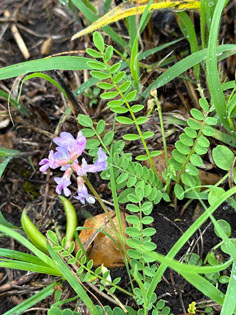OZARK MILK-VETCH
|
 |
| File Size: 226 KB |
|
|
|
Astragalus distortus T. & G.
|
| Anderson County, Kansas |
| Perennial |
| Height: 1 1/2 to 16 inches |
| Family: Fabaceae - Bean Family |
| Flowering Period: April, May |
|
| Stems: | | Prostrate to decumbent, usually glabrous below, sparsely strigose above. | | Leaves: | | Alternate, pinnately compound, 1 to 5 inches long; stipules distinct, ovate to lanceolate, 1/12 to 1/3 inch, glabrous; petiole present; leaflets 9-27, blades obovate to elliptic or oblanceolate, 1/12 to 1/2 inch long, 1/12 to 1/4 inch wide, apex round to truncate or retuse, margins entire, lower surface sparsely strigose, upper surface glabrous. | | Inflorescences: | | Racemes, 5-20-flowered, axillary; peduncles decumbent or prostrate, 1 to 6 inches; raceme axis 3/5 to 2 4/5 inch long. Pedicels to 1/10 inch long. | | Flowers: | | Papilionaceous; calyx campanulate, 1/8 to 1/4 inch, strigose; petals 5; corolla white, bluish white, lilac, or pinkish purple, 1/3 to 3/5 inch; banner ovate, 2/5 to 3/5 inch; wings 1/4 to 3/5 inch; keel 1/4 to 1/3 inch, slightly upturned distally, apex obtuse; stamens 10, 9 united, 1 free; style glabrous. | | Fruits: | | Pods, usually ascending, initially green, becoming brown or black, curved, crescent-shaped, slightly flattened in cross section, 2/5 to 1 inch long, 1/8 to 1/4 inch wide, initially fleshy, becoming leathery, glabrous; seeds 25--35, kidney to heart shaped, ca. 1/10 inch. | | Habitat: | | Rocky tallgrass prairies, glades | | Distribution: | | East 1/4 of Kansas | | Origin: | | Native | | Comments: | | Astragalus, vertebra or anklebone, which were used in ancient times as dice, possibly alluding to the rattling sound of the seeds in the legumes of some species, and distortus, twisted, alluding to the legumes. Seventeen species of Astragalus have been documented in Kansas. |
|
| Ozark milk-vetch |  | | 217 KB | | Anderson County, Kansas |
| | Ozark milk-vetch inflorescence |  | | 239 KB | | Anderson County, Kansas |
| | Ozark milk-vetch leaves |  | | 239 KB | | Anderson County, Kansas |
| | |
|
|
|
|
|
|